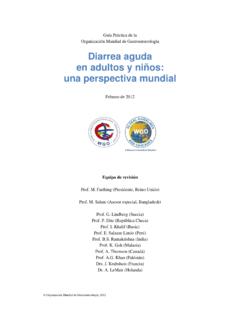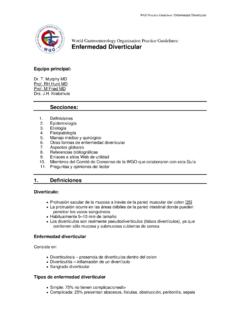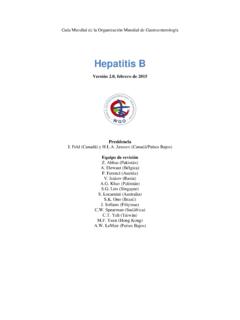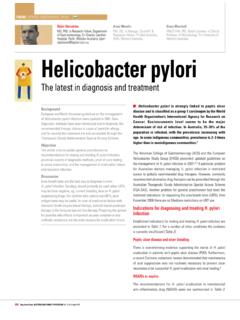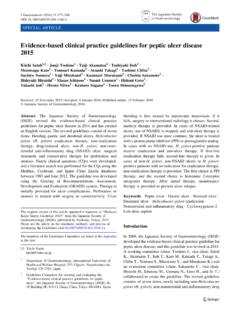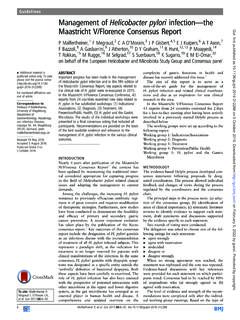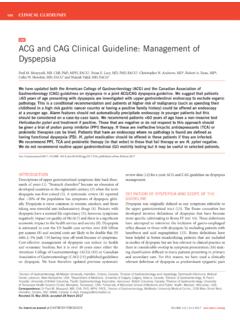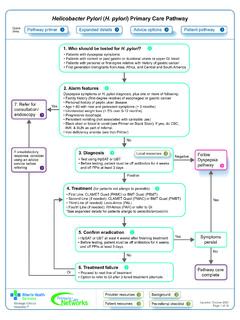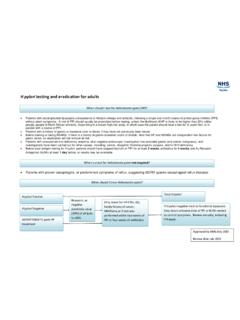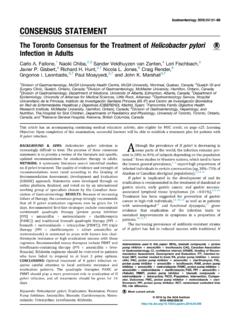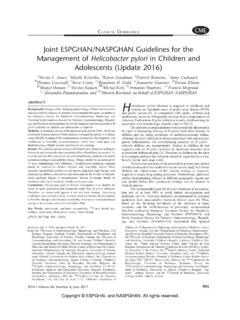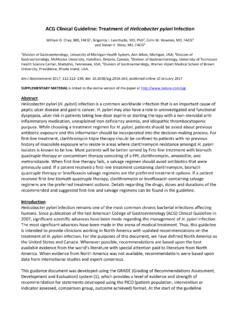Transcription of Helicobacter pylori - worldgastroenterology.org
1 WGO Global Guidelines Helicobacter pylori 1 World Gastroenterology Organisation, 2021 World Gastroenterology Organisation Global Guidelines Helicobacter pylori May 2021 Guideline Update Team Peter Katelaris (Co-Chair, Australia), Richard Hunt (Co-Chair, United Kingdom), Franco Bazzoli (Italy), Henry Cohen (Uruguay), Kwong Ming Fock (Singapore), Manik Gemilyan (Armenia), Peter Malfertheiner (Germany), Francis M graud (France), Alejandro Piscoya (Peru), Duc Quach (Vietnam), Nimish Vakil (USA), Louis G.
2 Vaz Coelho (Brazil), Anton LeMair (Netherlands) WGO Global Guidelines Helicobacter pylori 2 World Gastroenterology Organisation, 2021 Contents 1 Summary .. 4 2 Introduction .. 4 3 Natural history, transmission and epidemiology global aspects .. 5 Natural history of infection .. 5 Transmission of infection .. 6 Epidemiology .. 6 4 The impact of H. pylori infection and the effect of eradication .. 8 H. pylori and peptic ulcer disease .. 8 H. pylori and gastric cancer and MALT lymphoma.
3 9 H. pylori associated dyspepsia .. 10 5 Diagnosis of H. pylori infection .. 11 Who to test and treat? .. 11 6 How to test for H. pylori .. 11 Endoscopic diagnostic tests .. 11 Noninvasive diagnostic tests .. 13 Testing to assess the outcome after eradication therapy .. 14 Diagnostic pathways .. 14 Empirical therapy in low-resource regions .. 15 7 Treatment of H. pylori infection .. 16 8 Translating treatment principles into therapeutic choices .. 17 Choice of first-line eradication 17 PPI, amoxicillin, clarithromycin triple therapy.
4 18 Bismuth-based quadruple therapies .. 19 Nonbismuth quadruple therapies .. 20 Levofloxacin triple therapy .. 20 Choice of second and subsequent eradication therapies .. 22 Bismuth-based quadruple therapy and levofloxacin triple therapy .. 22 Other salvage therapies .. 22 Treatment choices for patients with penicillin allergy .. 23 Treatment pathways .. 23 The role of culture .. 26 Compliance .. 26 After treatment .. 27 WGO Global Guidelines Helicobacter pylori 3 World Gastroenterology Organisation, 2021 9 Regional views for best-practice eradication therapy based on local data and resources.
5 27 Australia .. 27 Pacific region .. 27 Southeast Asia .. 28 Eurasia .. 28 Western Europe .. 28 Southern Europe .. 29 North America .. 29 South and Central America .. 30 10 Abbreviations used in this WGO guideline .. 30 11 References .. 31 List of tables Table 1 Global burden of cancer in 2020 ..9 Table 2 Indications for treatment of H. pylori infection ..11 Table 3 Cascades: Diagnostic tests for H. pylori ..12 Table 4 Key principles guiding the choice of H. pylori eradication therapy.
6 16 Table 5 Pooled prevalences of primary and secondary antibiotic resistance ..18 Table 6 Overview of first-line eradication therapies ..21 Table 7 Triple therapies and quadruple-therapy combinations ..22 Table 8 Cascades: Treatment considerations for low-resource regions ..24 List of figures Fig. 1 Global prevalence of H. pylori ..6 Fig. 2 Prevalence of H. pylori in pediatric patients in Kuala Lumpur ..7 Fig. 3 Cascades: treatment pathways for low-resource regions ..15 Fig. 4 Treatment pathways for H.
7 pylori ..25 WGO Global Guidelines Helicobacter pylori 4 World Gastroenterology Organisation, 2021 1 Summary Helicobacter pylori continues to be a major health problem worldwide, causing considerable morbidity and mortality due to peptic ulcer disease and gastric cancer. The burden of disease falls disproportionately on less well-resourced populations. As with most infectious diseases, the greatest impact on reducing this burden comes from improvements in socioeconomic status, which interrupt transmission.
8 This has been observed in many regions of the world, but the prevalence of infection remains high in many regions in which improvements in living standards are slow to occur. Meanwhile, the optimal clinical management and treatment pathways remain unsettled and are evolving with changing antimicrobial resistance patterns. Despite decades of research and clinical practice, major challenges remain. The quest for the most effective, safe, and simple therapy is still a major issue for clinicians.
9 An effective vaccine also still appears to be elusive. Clinical guidelines not infrequently proffer discordant advice. It is very difficult for guidelines to achieve relevance across a variety of populations with varying spectrums of disease, antimicrobial resistance rates, and vastly different resources. As local factors are central to determining the impact and management strategies for H. pylori infection, it is important for pathways to be based on the best available local knowledge, rather than solely extrapolated from guidelines formulated in other regions, which may be less applicable.
10 To this end, this revision of the WGO H. pylori guideline uses a cascades approach that seeks to summarize the principles of management and offer advice for pragmatic, relevant, and achievable diagnostic and treatment pathways based on established key treatment principles and using local knowledge and available resources to guide regional practice. 2 Introduction Helicobacter pylori has been recognized as a major pathogen of humankind for nearly four decades. However, despite the impact of treatment of infected individuals and the reduced transmission of infection in communities in which socioeconomic living standards have improved, it continues to be the most common human bacterial pathogen, infecting perhaps half of the world s population [1].





